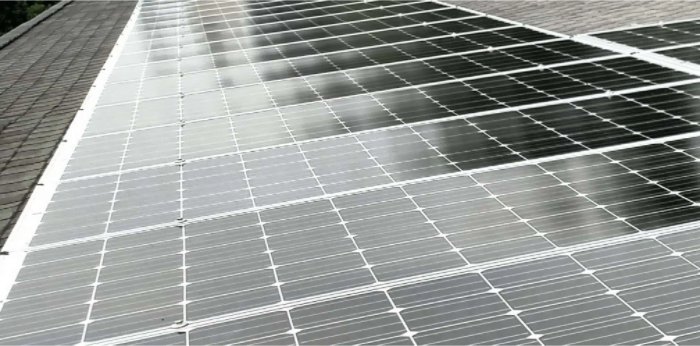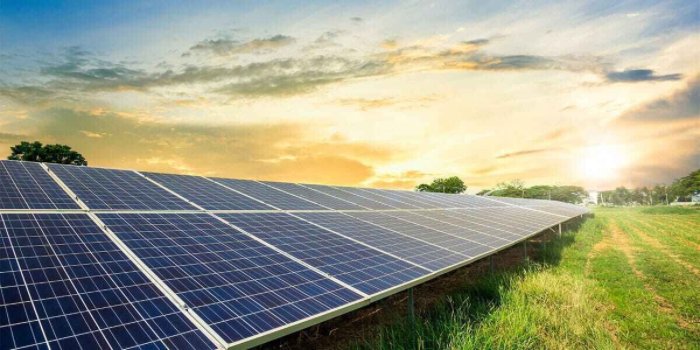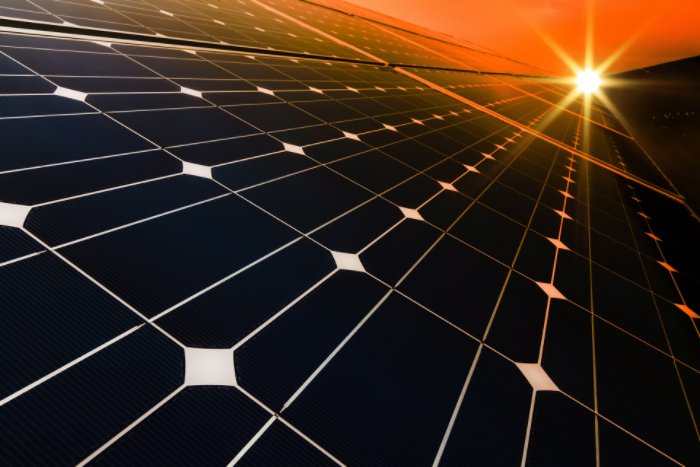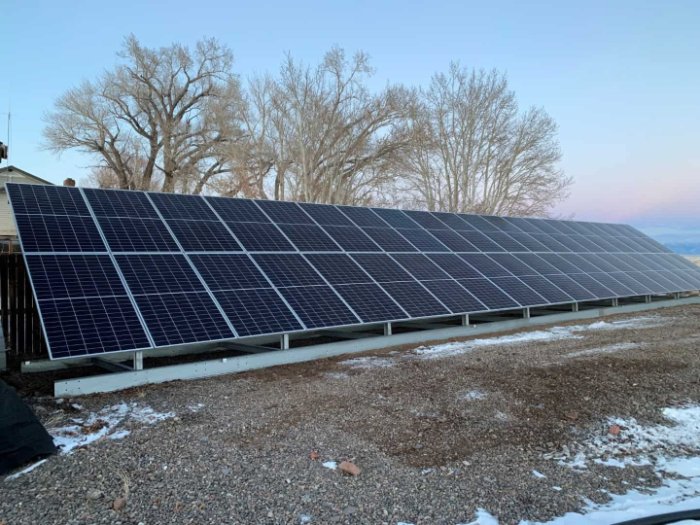Monocrystalline Solar Panels
Monocrystalline solar panels have long been recognized for their high efficiency even in the absense of visible light. This makes such panels the most suitable for countries with the overcast weather present throughout the year. Structure and material benefit Monocrystalline cells are made of a single incredibly pure crystal of silicon. This ideal structure allows the use of such cells to demonstrate the ray circulation unaffected by impurities usually found in other solar panel types. Consequently, the purity of the material and the structure of monocrystalline panels enhance their ability to satisfactorily operate in the lack of visible light. In general, monocrystalline solar panels offer 18-22% efficiency, which is among the highest for the type.

Performance in low light
Monocrystalline panels demonstrate higher efficiency in the diffuse daylight. For instance, it is possible to get a diminished proportion of light in the clouds during the overcast weather, yet these types of panel make it possible to get even the indirect amount of sunshine. By doinding the high-quality silicon, the ability to absorb the light makes it possible to maintain the corresponding amount of electricity. Studies have shown that monocrystalline solar panels provide an average of 25% more power from diffuse lighting than polycrystalline models.
Technology used to enhace low light performance
There are some peculiar technologies used in monocrystalline solar panels. For instance, PERC is a cell that uses the increased wavelengths of light resulting from the air molecules distributed in the clouds as the differential between the present and absent sunlight. The technology adds a layer just behind the cell, which functions as an absorber of the consequential longer wavelengths of light. Real-world applications show that this feature enhances the efficiency of the panels in overcast weather. Anti-reflective coating is another feature of these panels such as that the reflection of light is minimal. In this way, more light penetrates the panel, which makes it possible to receive and convert more energy that would be the case otherwise.
Polycrystalline Solar Panels
Polycrystalline solar panels can be considered as a more budget variant of energy production, and, in particular, they are best for the climate with frequent overcast days. While being comparable in efficient, this particular type of device is cheaper due to the unique way it is made and the materials used. The main benefits compared to the previous type are the relatively low cost and good performance for processing the energy from diffused sun rays.
Unique Way of Production and Economic Reasons
Polycrystalline cells are made by melting multiple silicon fragments all together, while monocrystalline panels require a pure, single-silicon crystal . This special characteristic significantly decreases the production price without large sacrifices of generated power. Typically, these panels are no more than 60-70% of monocrystalline solar panels in price, and the consumer can save 10-20% of total cost. This aspect makes polycrystalline celles one of the cheapest on the market today.
Performance Metrics in Overcast
The efficiency rate of Polycrystalline devices is approximately same and varies from 15% to 17%, meaning that this type of solar panels has 1-2% less efficient, compare to monocrystalline . While the aforementioned feature means that the falling performance cannot be called excellent by definition, the potential of a solar panel for working even with the conditions of falling sun is a vital advantage, as far as polycrystalline cells can do with lower temperature and weaker sunlight as well.
Field testing, in this case, shows that specific prototypes might generate less power per square foot while receiving direct sunlight. They will catch up as far as less radiant energy is way more concentrated due to bans of clouds, which means that Polycrystalline solar panels demonstrate excellent results in regular cloudy household climates.
Installation Can Influence on Maximum Performance
It is essential for the Polycrystal devices to be directed towards the most frequent path of sunlight, as falling efficiency can be compensated by a larger receipt of sunlight as well. It is also essential to use the unique way of putting a panel on the roof, called the “right angle to sunlight” method. While it varies from region to region and best approaches the angle of the sun’s low point, this tilt is equal to the latitude. This practice works the best in Northern Europe , where, through municipal cases, polycrystalline cells proved to be a perfect variant.
Flexible Choices for Variable Light
The characteristics of thin-film solar panels that are of the most interest are their adaptability and better performance in variable lighting conditions, which make them suitable for installation in places with variable weather. The panels are unique in that they can operate well both in low light and under any indirect light, making them genuinely versatile.
Unlike other solar technologies, thin-film solar panels are produced not with a crystalline but amorphous method. The panels are made by depositing one or more layers of photovoltaic material, such as cadmium telluride or amorphous silicon, on a substrate. As a result, they save the material and are 100 times smaller in total thickness than the conventional silicon wafers, which allows them to be more lightweight and utilizes various installation methods unavailable real for the usual stiff panels.
Thin-film solar panels also better utilize both direct and indirect sunlight. These panels have higher absorption coefficients because of the unique properties of the materials. In practical applications, their efficiency ranges from 10% to 13%, but they work best at sunny and partly cloudy days as well as overcast weather, when thin-film able to gain 10% more power output. An example of its operation is companies in Silicon Valley, which use thin-film solar panels as part of the building’s skylights and windows to provide sun and heat shading on one hand and to absorb both direct and reflected light on the other.
I find this technology the best for use in urban areas because of the most versatile performance in variable lighting. One urban example of its use is the Tokyo skyscrapers that cast shadows on each other. The use of silicon-based panels would result in significant production of electricity waste, but the best way to collect light under these conditions is through, also used for mobile solar chargers and power supplies. In unstructured rural areas, these chargers also excellently operate in partial light. Many companies also build these chargers and emergency solar power supplies from portable thin-film solar panels that can be easily moved to better light areas, and I would also consider installing these efficient solar rooftops if I lived in a place with variable sunlight, such as coastal areas.
IBC Technology
Interdigitated Back Contact technology stands out as a notable development in the production of solar panels, tailored to increase light absorption and electrical effectiveness, including during cloudy days. The technology restructures the architecture of the solar cell in such a way as to minimize losses and maximize output during low-light conditions.
Advanced Cell Architecture
The most significant difference between IBC solar cells and traditional panels is that all of the electrical contacts are on the rear side of the cell. This allows for no metal contacts on the front surface, which usually covers or shades the cell and diminishes light absorption. The IBC’s fully exposed surface captures more sunlight and converts it more effectively. As such, light conditions consisting of the diffuse and sparsely concentrated light characteristic of overcast days are sufficient for IBC cells to generate large amounts of energy.
Efficiency in Low-Light Conditions
During optimal, direct sunlight conditions, IBC panels’ efficiency typically varies from 20% to 24% . Comprehensively reestablishing the entire set of contacts to the back of the cell significantly enhances the competence in capturing light at a wide range of angles. In Northern Europe, a solar farm with IBC panels produced 15% more power during the winter months in comparison to standard panels, equivalent to the 15% capacity to collect diffuse sunlight that is reflected from or otherwise fails to reach the front of the cell.
Commercial and Residential Deployment
The technology’s influence on cloudy climates is also supported by real domestic use. In the Pacific Northwest in the United States, families have installed IBC panels on the roofs of their homes, and their daily energy yield has notably outstripped their neighbors’. In Seattle, one homeowner reports that their energy yield is up by 18% from the yield of the neighbors who installed traditional photovoltaic systems, with the difference reaching up to 30% on the days of the lowest production. The enhanced efficiency directly translates into increased energy savings and returns on investment, even in some of the United States’ least solar-friendly climates.
In addition to certain costly set-up procedures, the lower risk and higher cost of IBC technology may limit the rate of its adoption in commercial or residential contexts . However, its capacity for the horizontal occupation of tight spaces has also sparked interest amongst businesses in urban areas. When using IBC panels, businesses can produce their energy from most of their available roof space even during the most extended periods of overcast weather.

HJT Solar Panels
Heterojunction Technology panels are changing the solar industry due to their superpowers to generate power efficiently in diffuse lighting. Designed as a combination of monocrystalline silicon and amorphous silicon, HJT technology redefines the concept of overcast season for good.
New Cell Philosophy
The cell structure of HJT panels comprises a monocrystalline silicon layer placed between two layers of amorphous silicon. This design enhances the HJT solar cells’ capability to absorb the broader spectrum of sunlight, emphasizing the ultraviolet and infrared portions that account for the largest segment of diffuse light, common on an overcast day. Thus, by merging silicon’s potential to absorb photons from the visible part cultivated from the amorphous material and amorphous material’s interaction with other parts of the solar spectrum, HJT technology ensures high efficiency in diffuse lighting conditions.
Boosted Efficiency
HJT panels are known for delivering between 22% and 24% in efficiency, so they are generally recognized as high-performers. It implies that HJT technology efficiently transfers more sunlight into electricity than many other types of panels. Thus, in comparison with the usual type of solar panels, HJT products delivered 20% more electricity during the daylight hour-induced diffuse light in a region known for its overcast weather. As for the actual use of HJT technology, one of the most controversial cloudy locations, the Pacific Northwest, serves as the example of the switch from the former standard poly-crystalline systems to the new technology at a commercial facility. The outcome was the increase of the energy produced per year by almost 25%.
All-Day Production
Importantly, the ability of HJT panels to perform better in diffuse lighting than conventional systems also underlines the fact that they also generate energy better in the morning and evening than many other types of panels. For instance, a residential community in Northern Europe enhanced energy production on overcast days and the production during the morning and evening. The relocation to HJT also allowed them to cut grid usage.



